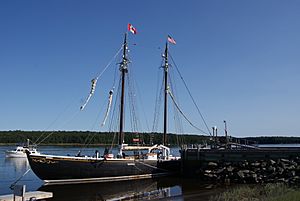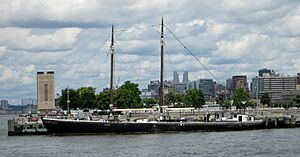Sherman Zwicker facts for kids

At the Maine Maritime Museum waterfront, September 2013
|
|
| History | |
|---|---|
| Owner |
|
| Builder | Smith and Rhuland |
| Yard number | 190 |
| Launched | 1942 |
| Status | Museum ship |
| General characteristics | |
| Tonnage | 180 GT |
| Length | 142 ft (43 m) |
| Propulsion | 320 bhp (240 kW) diesel engine |
| Sail plan | schooner |
The Sherman Zwicker is a wooden fishing schooner built in 1942. A schooner is a type of sailing ship with at least two masts. It was built in Lunenburg, Nova Scotia, at the same shipyard as the famous Bluenose.
The Sherman Zwicker was designed to catch fish in the Grand Banks. This area is known for its rich fishing grounds. The ship was named after F. Homer Zwicker, whose company owned it. Launched in 1942, the Sherman Zwicker is the last working "saltbank" fishing vessel still around today.
Contents
What is the Sherman Zwicker?
The Sherman Zwicker is a 142-foot-long wooden fishing schooner. It has a special design, much like its famous sister ship, the Bluenose. Both ships were built at the same shipyard.
Unlike the Bluenose, the Sherman Zwicker was built with a powerful 320-horsepower diesel engine from the start. It was made purely for fishing, not for racing. This means it didn't have tall topmasts or a long bowsprit like some racing schooners.
In the past, hundreds of wooden schooners like the Sherman Zwicker fished in the North Atlantic. This area, called the Grand Banks, was full of fish but also had rough seas. Today, fewer than five of these old fishing schooners still exist. The Sherman Zwicker is the only one that is fully working and has been restored.
A Look at the Sherman Zwicker's History
The Sherman Zwicker was built for Zwicker and Co. to fish the Grand Banks. Fishermen would use small boats called dories that launched from the schooner. They would fish near Lunenburg, Nova Scotia.
Later, it became hard to find enough crew for all 11 dories. So, from 1959 to 1968, the ship fished from Glovertown, Newfoundland. In 1959, it used eight dories with a crew of 18 people, all from Newfoundland.
Before ice and refrigeration were common, fishermen would salt their fish to keep it fresh. This is why these ships were called "saltbankers." In the 1950s and 1960s, new fishing trawlers became popular. These trawlers were more profitable. Because of this, the number of Grand Banks schooners dropped a lot. In 1963, political problems in Haiti hurt the market for salt fish. This made sales drop even more.
New Owners and New Life
In 1968, George McEvoy from Maine bought the Sherman Zwicker. He wanted to bring the ship back to its original condition. Today, the Sherman Zwicker is a traveling museum. It often visits the Maine Maritime Museum in Bath, Maine.
The ship also takes part in tall ship festivals along the Eastern Seaboard. It still visits its old home ports in Nova Scotia and Newfoundland, where it is welcomed with excitement.
How the Sherman Zwicker Was Designed
The Sherman Zwicker was designed by William James Roué. He also designed the Bluenose, which was known as the fastest racing schooner ever built. The Sherman Zwicker looks almost exactly like the Bluenose.
While the Bluenose was used for both racing and fishing, the Sherman Zwicker had a different main goal. It was built to keep the "saltbank" fishing fleet going longer. So, some small changes were made to its sails and engine to make it more efficient for fishing.
This meant it had the fast, sleek hull of the Bluenose. But it also had a strong Fairbanks Morse diesel engine and a simpler set of sails. At the time, it was seen as a "transition vessel." This means it was one of the first and last ships to move from relying only on sails to using diesel power.
The ship's keel was laid at the famous Smith and Rhuland Shipyard in Lunenburg, Nova Scotia. It was built by hand using heavy wood from old Canadian elm trees. The Sherman Zwicker was the last of hundreds of large wooden schooners. These ships fished the Grand Banks and carried fish and salt across the North Atlantic to South America.
The Sherman Zwicker's Current Status
The Grand Banks Schooner Museum Trust, a non-profit group led by Capt. McEvoy, took over the ship. Under this Trust, the Sherman Zwicker became a working, traveling museum. It went to many tall ship events along the East Coast. It also often visited its old ports in Nova Scotia and Newfoundland, where it was very popular. For almost 30 years, it spent its summers at the Maine Maritime Museum in Bath, Maine. There, tens of thousands of visitors explored the ship each season.
In 2014, the Grand Banks Schooner Museum Trust gave the Sherman Zwicker to the Maritime Foundation. This was done to make sure the ship would be saved for future generations. The Maritime Foundation found a new home for the ship at Hudson River Park’s Pier 25 in New York City. The ship is now kept in good condition using money from Grand Banks, an award-winning oyster bar that operates on its deck.
Gallery
-
Sherman Zwicker (left), and a sculpture representing Wyoming, at the Maine Maritime Museum in Bath, Maine
















